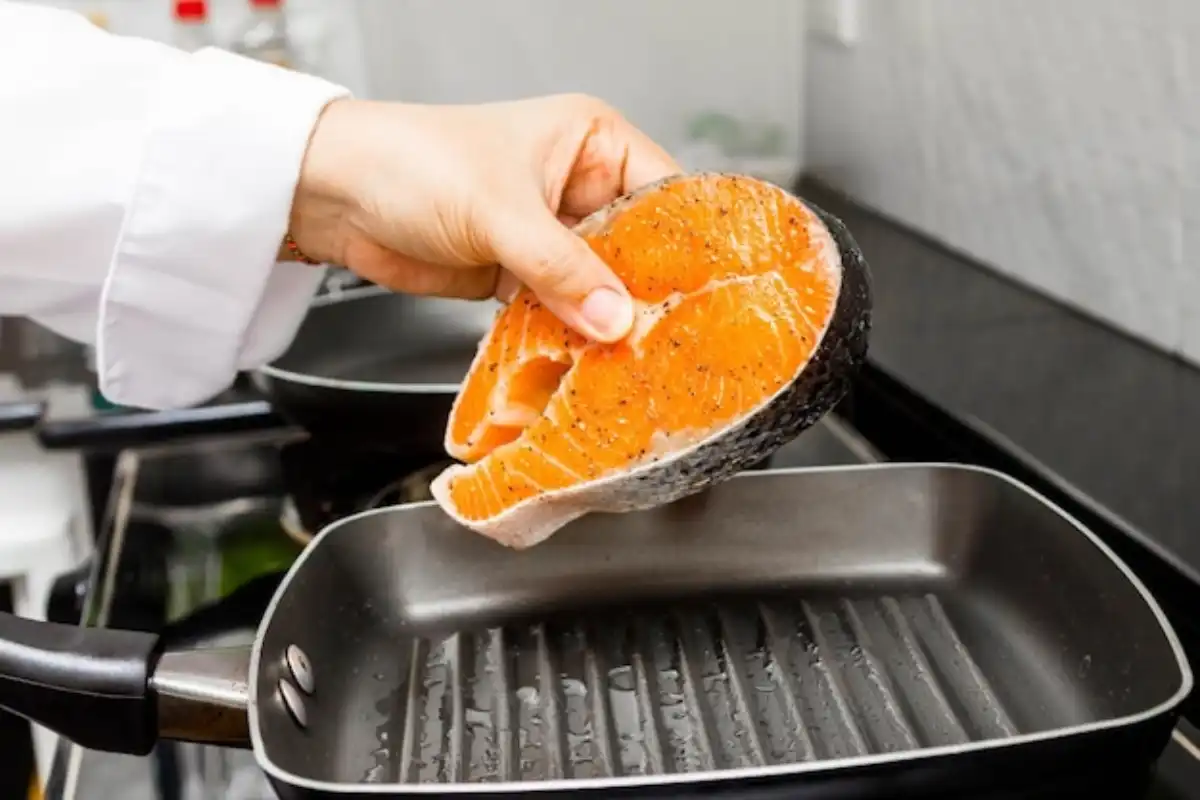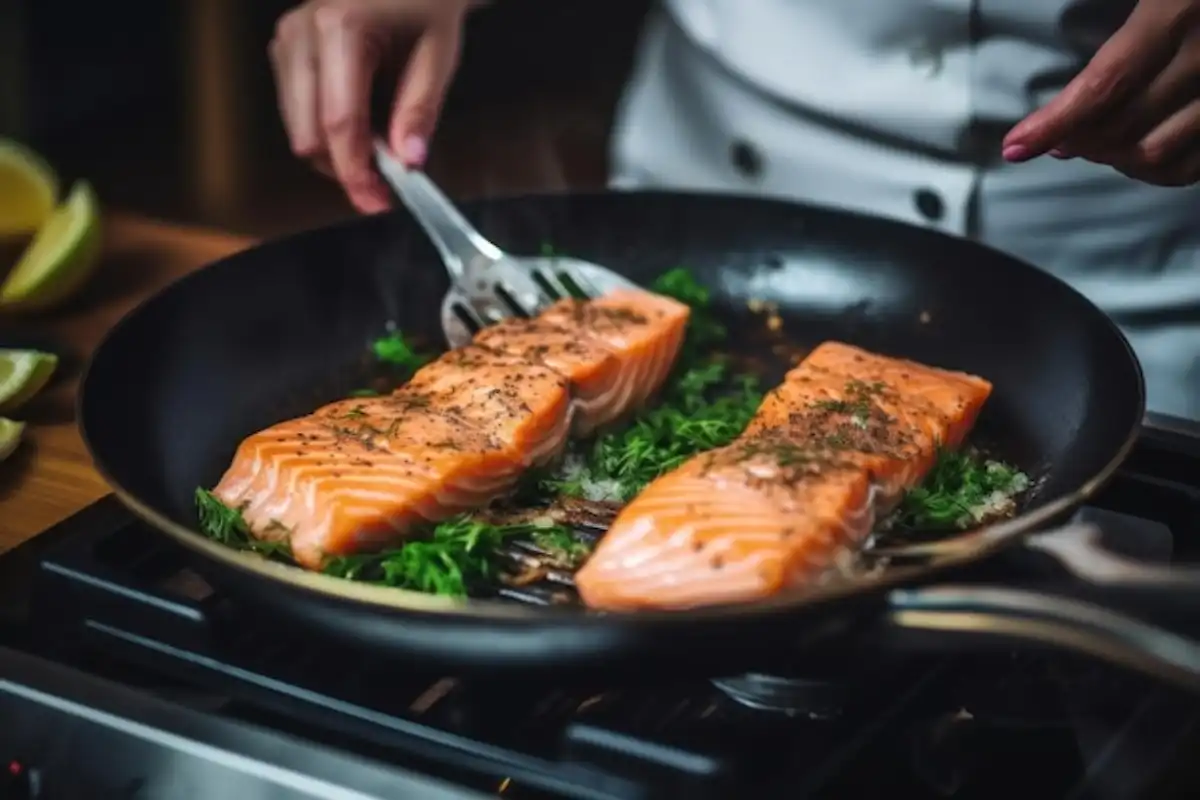Pan-frying salmon is one of the most popular methods for cooking this nutrient-packed fish. Pan-fried salmon, renowned for its rich flavor, crispy skin, and tender interior, is a versatile dish that lends itself to a variety of preparation methods. Whether you’re new to cooking or looking to perfect your technique, this guide will take you through the steps of properly pan-frying salmon, from selecting the right fillet to mastering the cooking process.
In addition to a step-by-step breakdown, we’ll explore common mistakes to avoid, flavor enhancements, and side dish pairings that will elevate your pan-fried salmon to new culinary heights. Let’s dive into the details.
Part 1: Introduction to Pan-Frying Salmon
Why is Pan-Frying the Best Method for Salmon?
Pan-frying salmon is a fast, simple, and effective cooking technique that allows you to achieve a beautifully crisp exterior while keeping the interior moist and flavorful. Unlike baking or grilling, pan-frying gives you greater control over the temperature and cooking time, which helps prevent overcooking—a common issue with salmon.
This method is especially beneficial for those who want a quick yet delicious meal. Whether you’re cooking a weeknight dinner or preparing a special meal, pan-frying delivers a restaurant-quality dish with minimal effort.
The Health Benefits of Salmon
Salmon is renowned for its health benefits. Omega-3 fatty acids, essential for heart and brain health, and high-quality protein, aiding in muscle repair and growth, are abundant in salmon. Rich in vitamins B12, D, and selenium, salmon is a nutritional powerhouse that can support overall well-being.
If you’re new to cooking salmon, selecting the right fish is crucial. For tips on how to pick the best salmon, check out this guide on How to Choose the Best Salmon.
Part 2: Preparing Salmon for Pan Frying
1. Choosing the right salmon
Before pan-frying, it’s important to select high-quality salmon. When shopping, you’ll find both fresh and frozen options. Both are great, but fresh, wild-caught salmon is generally considered superior in terms of flavor and texture.
- Fresh vs. frozen: Fresh salmon often has a richer taste, but frozen salmon can be just as tasty when thawed properly. Make sure to fully defrost and pat dry frozen salmon before cooking to ensure it crisps up nicely.
- Skin-On vs. Skinless: Skin-on fillets are ideal for pan-frying because the skin becomes crispy and helps protect the flesh from drying out. You can also use skinless fillets but exercise caution to prevent overcooking.
2. Prepping the Salmon Fillets
Once you’ve selected your salmon, it’s time to prepare it for pan-frying. Start by removing any remaining pin bones from the fillets using tweezers. Then, pat the salmon fillets dry with a paper towel—this is crucial for achieving crispy skin.
3. Seasoning the salmon
Keep the seasoning simple to let the salmon’s natural flavor shine. A basic combination of salt, pepper, and olive oil is all you need for a delicious meal. However, you can enhance the flavor with additional ingredients such as lemon zest, garlic, or fresh herbs like dill or parsley.
Part 3: A Step-by-Step Guide to Pan-Frying Salmon
1. The correct pan for the job
The pan you use greatly influences the success of your salmon. Opt for a non-stick skillet or cast-iron pan for the best results. These pans heat evenly and help prevent sticking, ensuring your salmon cooks to perfection.
2. Heating the pan
Before adding the salmon, make sure your pan is properly heated. Place the pan over medium-high heat and let it warm up for a few minutes. Add a tablespoon of oil (olive or avocado oil is ideal) and allow it to shimmer before placing the salmon in the pan.
3. Cooking the Salmon: Skin-side down first
Always start cooking the salmon with the skin side down. This allows the skin to crisp up and protects the delicate flesh from the direct heat of the pan. Cook the skin-side for about 3-4 minutes, or until the skin is crispy and golden brown.
4. Flipping the Salmon
After cooking the skin side, flip the salmon carefully using a spatula. Cook the other side for 1-2 minutes, depending on the thickness of the fillet. For medium doneness, the salmon should reach an internal temperature of 145°F (63°C) and flake easily with a fork.
5. Basting for Extra Flavor
For an extra burst of flavor, you can baste the salmon with butter and herbs during the last minute of cooking. Add a tablespoon of butter to the pan along with some garlic, thyme, or rosemary. Tilt the pan and use a spoon to baste the melted butter over the fillets.
Part 4: Common Mistakes to Avoid When Pan-Frying Salmon

1. Overcrowding the Pan
Overcrowding the pan is one of the most common mistakes when pan-frying salmon. This prevents the fillets from cooking evenly and developing a crispy exterior. Make sure there is enough space between the fillets for the heat to circulate properly.
2. Using Cold Salmon
Cooking cold salmon straight from the fridge can lead to uneven cooking. Allow the salmon to come to room temperature for about 10–15 minutes before frying to ensure even heat distribution.
3. Flipping Too Soon
Flipping the salmon too early is another common mistake. Let the skin crisp up fully before flipping—if the fish resists when you try to lift it, give it more time.
4. Using too much oil or butter
While fat is necessary for frying, using too much oil or butter can make the salmon greasy. Stick to about a tablespoon of oil, and only add butter at the end for basting.
5. Overcooking the salmon
Salmon cooks quickly, and it’s easy to overcook. Monitor the fish closely and verify its doneness with a thermometer or the flake test. Overcooked salmon will be dry and tough, so it’s better to undercook slightly, as the residual heat will continue to cook the fish.
Part 5: Variations and Flavor Enhancements
1. Classic Lemon and Dill Salmon
For a fresh and zesty flavor, add lemon slices and fresh dill to the pan while cooking. The lemon enhances the salmon’s natural flavor, while the dill adds a mild herbal note.
2. Garlic Butter-Basted Salmon
To make garlic butter-basted salmon, simply add a few cloves of crushed garlic to the pan, along with butter and herbs. This creates a rich, savory sauce that complements the fish beautifully.
3. Asian-Inspired Pan-Fried Salmon
For an Asian twist, marinate the salmon in a mixture of soy sauce, ginger, and sesame oil before pan-frying. This creates a flavorful, umami-rich dish that pairs well with steamed rice and vegetables.
4. Spicy Pan-Fried Salmon
If you like a bit of heat, sprinkle chili flakes, paprika, or cayenne pepper on the salmon before cooking. Serve with a squeeze of lime juice to balance the spice.
Part 6: Nutritional Benefits of Pan-Fried Salmon
1. High in Omega-3 Fatty Acids
Omega-3 fatty acids, found in salmon, can reduce inflammation, improve heart health, and support brain function. These healthy fats remain intact during the cooking process, making pan-fried salmon a highly nutritious meal. Learn more about the benefits of omega-3 fatty acids.
2. An excellent source of lean protein
In addition to healthy fats, salmon provides a substantial amount of lean protein. Protein is essential for muscle growth, tissue repair, and maintaining a healthy immune system. A typical salmon fillet contains around 20–25 grams of protein.
3. Low in carbs, high in nutrients
Pan-fried salmon is naturally low in carbohydrates, making it a beneficial option for those following low-carb or keto diets. It’s also packed with essential nutrients like vitamin B12, vitamin D, and selenium, all of which support overall health.
For more healthy salmon recipe ideas, check out Easy Healthy Salmon Recipes.
Part 7: FAQs About Pan-Frying Salmon
1. Should you cook salmon skin-side down first?
Yes, always start with the skin side down. This ensures that the skin crisps up nicely and the fillet doesn’t overcook.
2. How can you determine the completion of pan-fried salmon?
When the salmon flakes easily with a fork and reaches an internal temperature of 145°F (63°C), it is ready.
3. What oil should I use to pan-fry salmon?
Use oils with a high smoke point, such as olive oil, avocado oil, or clarified butter, to prevent burning.
4. Can you pan-fry frozen salmon?
It’s best to thaw frozen salmon before pan-frying to ensure even cooking. However, if you must cook from frozen, adjust the cooking time and be sure to dry the salmon thoroughly.
5. How can I make sure the salmon doesn’t stick to the pan?
Make sure the pan is hot enough and well-oiled before adding the salmon. Also, don’t attempt to move the salmon too soon after placing it in the pan—let it cook and release naturally.
Part 8: What to Serve with Pan-Fried Salmon
1. Complementary side dishes
Pan-fried salmon pairs well with a variety of side dishes. For a simple and healthy meal, try serving it with roasted vegetables like Brussels sprouts, asparagus, or broccoli. Steamed rice, mashed potatoes, or quinoa are also excellent options for adding some hearty starch to your meal.
For more dinner inspiration, try this garlic parmesan chicken pasta recipe.
2. Wine pairings
Salmon is a versatile fish that pairs well with both white and red wines. For pan-fried salmon, opt for a light, crisp white wine like Sauvignon Blanc or Chardonnay. If you prefer red wine, Pinot Noir is an excellent choice.
For a comforting side, pair your salmon with a side like this Ultimate Guide to Slow Cooker Soup.
Conclusion
Pan-frying salmon is a simple yet delicious way to prepare this nutrient-rich fish. Every time you follow the right steps—choosing the right fillet, properly heating the pan, and avoiding common mistakes—you can achieve perfectly crispy skin and a tender, flavorful interior. Whether you prefer a classic lemon and herb combination or want to experiment with bold flavors like garlic butter or spicy seasonings, pan-fried salmon is a versatile dish that’s sure to impress.
For a lighter dessert after your salmon meal, check out this simple No-Bake Cheesecake Filling.
By mastering the art of pan-frying salmon, you’ll be able to enjoy a quick, healthy, and incredibly tasty meal any day of the week.
